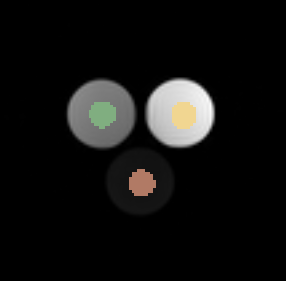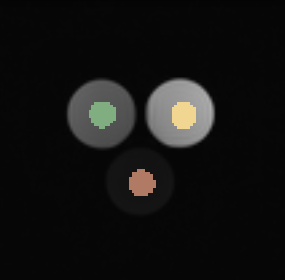Difference between revisions of "Documentation/Nightly/Extensions/DICOMPhilipsRescalePlugin"
(Prepend documentation/versioncheck template. See http://na-mic.org/Mantis/view.php?id=2887) |
|||
| (2 intermediate revisions by one other user not shown) | |||
| Line 1: | Line 1: | ||
| + | <noinclude>{{documentation/versioncheck}}</noinclude> | ||
<!-- ---------------------------- --> | <!-- ---------------------------- --> | ||
{{documentation/{{documentation/version}}/module-header}} | {{documentation/{{documentation/version}}/module-header}} | ||
| Line 30: | Line 31: | ||
Most frequently used for these scenarios: | Most frequently used for these scenarios: | ||
* Quantitative measurements from the un-processed MR images obtained on a Philips scanner. | * Quantitative measurements from the un-processed MR images obtained on a Philips scanner. | ||
| + | |||
| + | In the example below, the upper two tubes have the same medium in all four imaging experiment. For the images in the top row, the bottom vial was filled with 0% gadolinium solution. In the bottom row, it t was filled with 2% gadolinium solution. Images on the left were read using the standard DICOM ScalarVolumPlugin of Slicer, images on the right -- intensities were rescaled using Philips private DICOM tags. | ||
| + | |||
| + | * Standard reader: | ||
| + | ** 0% concentration for Vial3: ROI1: 987, ROI2: 1785, ROI3: 160 | ||
| + | ** 2% concentration for Vial3, Vials 1&2 unchanged: ROI1: 521, ROI2: 926, ROI3: 1980 | ||
| + | * Philips-specific reader: | ||
| + | ** 0% concentration for Vial3: ROI1: 40584, ROI2: 74084, ROI3: 6632 | ||
| + | ** 2% concentration for Vial3: ROI1: 41943, ROI2: 74935, ROI3: 158745 | ||
| + | |||
| + | The medium in Vials 1&2 remains the same, but signal changes when standard import procedures are used. | ||
| + | |||
| + | The imaging experiment has been designed and conducted by Tom Chenevert, University of Michigan. | ||
{| | {| | ||
Latest revision as of 08:05, 14 June 2013
Home < Documentation < Nightly < Extensions < DICOMPhilipsRescalePlugin
|
For the latest Slicer documentation, visit the read-the-docs. |
Introduction and Acknowledgements
|
This work is supported by NA-MIC, NAC, NCIGT, and the Slicer Community. This work is partially supported by Brain Science Foundation and NIH U01 CA151261. | |||||||
|
Module Description
This plugin applies manufacturer-specific scaling to the image data collected using Philips MR scanner on its import from DICOM into Slicer. Without applying such scaling, the voxel data stored in the image is not quantitative, i.e., measured values may not be comparable across images. The rescale procedure was provided by Tom Chenevert, U.Michigan, as part of NCI Quantitative Imaging Network Bioinformatics Working Group activities.
WARNING: this plugin should be used only for the un-processed images obtained from the scanner. For the derived images, such as Apparent Diffusion Coefficient or Fractional Anisotropy maps, Philips software creates DICOM images with valid rescaling information stored in the standard rescale tags of DICOM. There is no need to account for private rescaling tags for such images.
Use Cases
Most frequently used for these scenarios:
- Quantitative measurements from the un-processed MR images obtained on a Philips scanner.
In the example below, the upper two tubes have the same medium in all four imaging experiment. For the images in the top row, the bottom vial was filled with 0% gadolinium solution. In the bottom row, it t was filled with 2% gadolinium solution. Images on the left were read using the standard DICOM ScalarVolumPlugin of Slicer, images on the right -- intensities were rescaled using Philips private DICOM tags.
- Standard reader:
- 0% concentration for Vial3: ROI1: 987, ROI2: 1785, ROI3: 160
- 2% concentration for Vial3, Vials 1&2 unchanged: ROI1: 521, ROI2: 926, ROI3: 1980
- Philips-specific reader:
- 0% concentration for Vial3: ROI1: 40584, ROI2: 74084, ROI3: 6632
- 2% concentration for Vial3: ROI1: 41943, ROI2: 74935, ROI3: 158745
The medium in Vials 1&2 remains the same, but signal changes when standard import procedures are used.
The imaging experiment has been designed and conducted by Tom Chenevert, University of Michigan.
Tutorials
None.
User guide
The module will recognize Philips dataset when it is selected in DICOM Module of 3D Slicer. It will parse private tags in the dataset and will apply rescaling following the following formula:
QuantitativeValue = [SV-ScInt] / ScSlp, where SV = stored DICOM pixel value, ScInt = Scale Intercept = (2005,100d), ScSlp = Scale Slope = (2005,100e). |
Similar Modules
N/A
References
Information for Developers
| Section under construction. |
Source code: https://github.com/fedorov/DICOMPhilipsRescalePlugin







